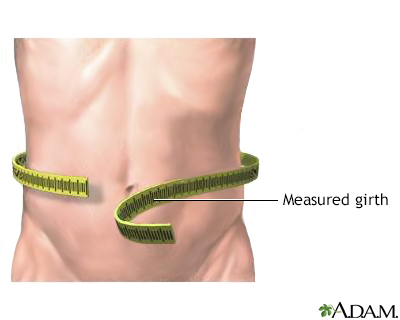Metabolic syndrome
Insulin resistance syndrome; Syndrome X
Metabolic syndrome is a name for a group of risk factors that occur together and increase the chance of having coronary artery disease, stroke, and type 2 diabetes.

The measurement of the abdominal girth may be helpful in diagnosing abdominal distention, which commonly results from intestinal gas or fluid. Increased abdominal girth may also indicate disease of the intestines or liver.
Causes
Metabolic syndrome is very common in the United States. About one fourth of Americans are affected and risk increases with age and among certain ethnicities. Doctors are not sure whether the syndrome is due to one single cause. But many of the risks for the syndrome are related to obesity. Many people with metabolic syndrome used to be told they had pre-diabetes, early hypertension (high blood pressure) or mild hyperlipidemia (high fats in the blood).
The two most important risk factors for metabolic syndrome are:
- Extra weight around the middle and upper parts of the body (central obesity). This body type may be described as "apple-shaped."
- Insulin resistance -- Insulin is a hormone produced in the pancreas. Insulin is needed to help control the amount of sugar in the blood. Insulin resistance means that some cells in the body use insulin less effectively than normal. As a result, blood sugar level rises, which causes insulin production to rise. This may increase the amount of body fat.
Other risk factors include:
- Aging
- Genes that make you more likely to develop this condition
- Changes in male, female, and stress hormones
- Lack of exercise
People who have metabolic syndrome often have one or more other factors that may be linked with the condition, including:
- Increased risk for blood clotting
- Increased levels of blood substances that are a sign of inflammation throughout the body
- Small amounts of a protein called albumin in the urine
Exams and Tests
Your health care provider will examine you. You'll be asked about your overall health and any symptoms you're having. Blood tests may be ordered to check your blood sugar, cholesterol, and triglyceride levels.
You'll likely be diagnosed with metabolic syndrome if you have three or more of the following signs:
- Blood pressure equal to or higher than 130/85 mm Hg or you're taking medicine for high blood pressure
- Fasting blood sugar (glucose) from 100 to 125 mg/dL (5.6 to 7 mmol/L) or you've been diagnosed with and are taking medicines for diabetes
- Large waist circumference (length around the waist): For men, 40 inches (102 centimeters [cm]) or more; for women, 35 inches (89 cm) or more [for people of Asian ancestry 35 inches (89 cm) for men and 30 inches (76 cm) for women]
- Low HDL (good) cholesterol: For men, less than 40 mg/dL (1.04 mmol/L); for women, less than 50 mg/dL (1.29 mmol/L) or you're taking medicine for reduced HDL
- Fasting levels of triglycerides equal to or higher than 150 mg/dL (1.69 mmol/L) or you're taking medicine to lower triglycerides
Treatment
The goal of treatment is to reduce your risk for heart disease, stroke, and diabetes.
Your provider will recommend lifestyle changes or medicines:
- Lose weight. The goal is to lose between 7% and 10% of your current weight. You will probably need to eat 500 to 1,000 fewer calories per day. A variety of diet options can help people achieve this goal. There is no single ‘best’ diet to lose weight.
- Get 150 minutes a week of moderate intensity exercise such as walking. Do exercises to strengthen your muscles 2 days a week. High intensity exercise for shorter periods is another option. Check with your provider to see if you are healthy enough to start a new exercise program.
- Lower your cholesterol by eating healthier foods, losing weight, exercising, and taking cholesterol-lowering medicines, if needed.
- Lower your blood pressure by eating less salt, losing weight, exercising, and taking medicine, if needed.
Your provider may recommend daily low-dose aspirin.
If you smoke, now is the time to quit. Ask your provider for help quitting. There are medicines and programs that can help you quit.
Outlook (Prognosis)
People with metabolic syndrome have an increased long-term risk of developing heart disease, type 2 diabetes, stroke, kidney disease, and poor blood supply to the legs.
When to Contact a Medical Professional
Contact your provider if you have signs or symptoms of this condition.
References
American Heart Association website. About metabolic syndrome.
National Heart, Lung, and Blood Institute website. Metabolic syndrome.
Raynor HA, Morgan-Bathke M, Baxter SD, et al. Position of the Academy of Nutrition and Dietetics: Medical nutrition therapy behavioral interventions provided by dietitians for adults with overweight or obesity, 2024. J Acad Nutr Diet. 2024 ;124(3):408-415. PMID: 38040115
Ruderman NB, Shulman GI. Metabolic syndrome In: Robertson RP, ed. DeGroot's Endocrinology. 8th ed. PA: Elsevier; 2023:chap 26.
Version Info
Last reviewed on: 5/20/2024
Reviewed by: Sandeep K. Dhaliwal, MD, board-certified in Diabetes, Endocrinology, and Metabolism, Springfield, VA. Also reviewed by David C. Dugdale, MD, Medical Director, Brenda Conaway, Editorial Director, and the A.D.A.M. Editorial team.
